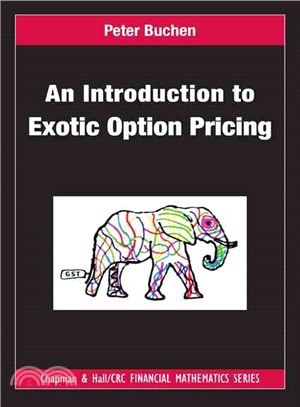| FindBook |
有 1 項符合
An Introduction to Exotic Option Pricing的圖書 |
 |
An Introduction to Exotic Option Pricing 作者:Buchen,Peter 出版社:Taylor & Francis 出版日期:2012-02-03 語言:英文 規格:15.2 x 22.9 x 1.9 cm / 普通級/ 雙色印刷 |
| 圖書館借閱 |
| 國家圖書館 | 全國圖書書目資訊網 | 國立公共資訊圖書館 | 電子書服務平台 | MetaCat 跨館整合查詢 |
| 臺北市立圖書館 | 新北市立圖書館 | 基隆市公共圖書館 | 桃園市立圖書館 | 新竹縣公共圖書館 |
| 苗栗縣立圖書館 | 臺中市立圖書館 | 彰化縣公共圖書館 | 南投縣文化局 | 雲林縣公共圖書館 |
| 嘉義縣圖書館 | 臺南市立圖書館 | 高雄市立圖書館 | 屏東縣公共圖書館 | 宜蘭縣公共圖書館 |
| 花蓮縣文化局 | 臺東縣文化處 |
|
|
- 圖書簡介
Fully derives every price formula for the exotic options
Develops special pricing techniques based on the no-arbitrage principle
Contains a significant amount of original, previously unpublished material, such as the use of log-volutions and Mellin transforms to solve the Black?choles PDE
Demystifies many esoteric issues underpinning the mathematical treatment of the subject
Includes challenging problems at the end of each chapter to illustrate the special pricing techniques
Solutions manual available with qualifying course adoption
In an easy-to-understand, nontechnical yet mathematically elegant manner, An Introduction to Exotic Option Pricing shows how to price exotic options, including complex ones, without performing complicated integrations or formally solving partial differential equations (PDEs). The author incorporates much of his own unpublished work, including ideas and techniques new to the general quantitative finance community.
The first part of the text presents the necessary financial, mathematical, and statistical background, covering both standard and specialized topics. Using no-arbitrage concepts, the Black?choles model, and the fundamental theorem of asset pricing, the author develops such specialized methods as the principle of static replication, the Gaussian shift theorem, and the method of images. A key feature is the application of the Gaussian shift theorem and its multivariate extension to price exotic options without needing a single integration.
The second part focuses on applications to exotic option pricing, including dual-expiry, multi-asset rainbow, barrier, lookback, and Asian options. Pushing Black?choles option pricing to its limits, the author introduces a powerful formula for pricing a class of multi-asset, multiperiod derivatives. He gives full details of the calculations involved in pricing all of the exotic options.
Taking an applied mathematics approach, this book illustrates how to use straightforward techniques to price a wide range of exotic options within the Black?choles framework. These methods can even be used as control variates in a Monte Carlo simulation of a stochastic volatility model. - 作者簡介
Peter Buchen is an Associate Professor of Finance at the University of Sydney Business School. Dr. Buchen is co-founder of the Sydney Financial Mathematics Workshop, has authored many publications in financial mathematics, and has taught courses in quantitative finance and derivative securities. His research focuses on mathematical methods for valuing exotic options.
- 目次
TECHNICAL BACKGROUND
Financial Preliminaries
European Derivative Securities
Exotic Options
Binary Options
No-Arbitrage
Pricing Methods
The Black?choles PDE Method
Derivation of Black?choles PDE
Meaning of the Black?choles PDE
The Fundamental Theorem of Asset Pricing
The EMM Pricing Method
Black?choles and the FTAP
Effect of Dividends
Mathematical Preliminaries
Probability Spaces
Brownian Motion
Stochastic Des
Stochastic Integrals
It繫? Lemma
Martingales
Feynman-Kac Formula
Girsanov? Theorem
Time Varying Parameters
The Black?choles PDE
The BS Green? Function
Log-Volutions
Gaussian Random Variables
Univariate Gaussian Random Variables
Gaussian Shift Theorem
Rescaled Gaussians
Gaussian Moments
Central Limit Theorem
Log-Normal Distribution
Bivariate Normal
Multivariate Gaussian Statistics
Multivariate Gaussian Shift Theorem
Multivariate It繫? Lemma and BS-PDE
Linear Transformations of Gaussian RVs
APPLICATIONS TO EXOTIC OPTION PRICING
Simple Exotic Options
First-Order Binaries
BS-Prices for First-Order Asset and Bond Binaries
Parity Relation
European Calls and Puts
Gap and Q-Options
Capped Calls and Puts
Range Forward Contracts
Turbo Binary
The Log-Contract
Pay-at-Expiry and Money-Back Options
Corporate Bonds
Binomial Trees
Options on a Traded Account
Dual Expiry Options
Forward Start Calls and Puts
Second-Order Binaries
Second-Order Asset and Bond Binaries
Second-Order Q-Options
Compound Options
Chooser Options
Reset Options
Simple Cliquet Option
Two-Asset Rainbow Options
Two-Asset Binaries
The Exchange Option
Options on the Minimum/Maximum of Two Assets
Product and Quotient Options
ICIAM Option Competition
Executive Stock Option
Barrier Options
Introduction
Method of Images
Barrier Parity Relations
Equivalent Payoffs for Barrier Options
Call and Put Barrier Options
Barrier Option Rebates
Barrier Option Extensions
Binomial Model for Barrier Options
Partial Time Barrier Options
Double Barriers
Sequential Barrier Options
Compound Barrier Options
Outside-Barrier Options
Reflecting Barriers
Lookback Options
Introduction
Equivalent Payoffs for Lookback Options
The Generic Lookback Options m(x, y, t) and M(x, z, t)
The Standard Lookback Calls and Puts
Partial Price Lookback Options
Partial Time Lookback Options
Extreme Spread Options
Look-Barrier Options
Asian Options
Introduction
Pricing Framework
Geometric Mean Asian Options
FTAP Method for GM Asian Options
PDE Method for GM Asian Options
Discrete GM Asian Options
Exotic Multi-Options
Introduction
Matrix and Vector Notation
The M-Binary Payoff
Valuation of the M-Binary
Previous Results Revisited
Multi-Asset, One-Period Asset and Bond Binaries
Quality Options
Compound Exchange Option
Multi-Asset Barrier Options
References
Index
A Summary and Exercises appear at the end of each chapter.
|











